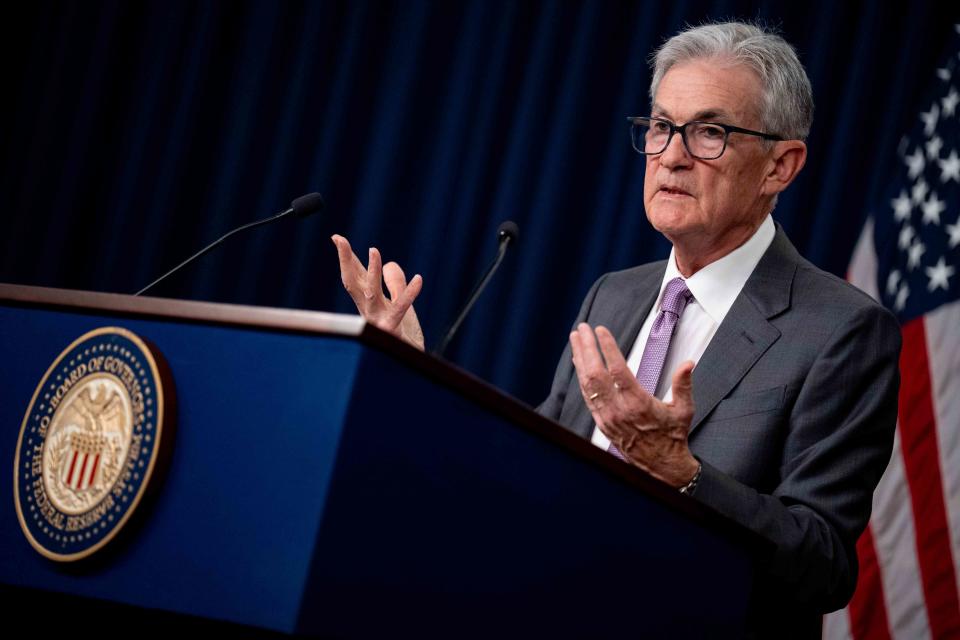” src=”https://s.yimg.com/ny/api/res/1.2/H9LstGzOTOSRbPRXf93OeQ–/YXBwaWQ9aGlnaGxhbmRlcjt3PTk2MDtoPTY0MA–/https://media.zenfs.com/en/investopedia_245/f22e34e21e552b0d1a894841fbd7e0d2″ data-src=”https://s.yimg.com/ny/api/res/1.2/H9LstGzOTOSRbPRXf93OeQ–/YXBwaWQ9aGlnaGxhbmRlcjt3PTk2MDtoPTY0MA–/https://media.zenfs.com/en/investopedia_245/f22e34e21e552b0d1a894841fbd7e0d2″>

How Will Friday’s Jobs Report Affect The Fed’s Decision on Interest Rate Cuts?
Andrew Harnik / Getty Images
Key Takeaways
-
A worse-than-expected report on the labor market in August raised the odds that the Federal Reserve would open its rate cut campaign in September with a jumbo 50-point cut.
-
Job growth fell short of expectations, while previous months were downwardly revised sharply.
-
However, a smaller rate cut was still on the table since not all the data was discouraging: the unemployment rate fell after unexpectedly spiking in July.
Fresh data showing the labor market decelerating adds pressure to the Federal Reserve to cut interest rates faster, but not enough to make a jumbo-sized rate cut a foregone conclusion.
Friday’s report on the job market from the Department of Labor showed the economy added 142,000 jobs in August, short of the 161,000 economists had forecast. Not only that, but the previous two months of already lackluster job growth were downwardly revised by a total of 86,000.
The report affected the outlook for interest rates on all kinds of loans. With the job market still cooling, some investors view Fed officials as more likely to cut the key fed funds rate by half a point at their next meeting rather than a less aggressive quarter-point cut.
The odds of a jumbo rate cut jumped in the wake of the report as investors tried to digest what this report could mean for the central bank.
Not A Clear Cut Case For a Quarter-Point Cut
The report didn’t cut strongly enough one way or the other to make it obvious which way the Fed would decide.
The data also showed that the unemployment rate dipped to 4.2% from 4.3% in July. Job growth in August was also better than the 89,000 jobs added in July. That’s a positive sign that the market was rebounding somewhat after an unexpected slump that may have been partly due to the weather.
“There were many mixed elements in today’s report that leaves the Fed call up in the air, and upcoming Fed speakers’ insights will provide some clues into how they are reading today’s report,” Ali Jaffery, an economist at CIBC, wrote in a commentary.
Chances Could Continue To Shift Before Meeting
Rate cut bets swung up and down as markets digested the mixed data, with the odds of a 50 basis point cut getting as high as 59% before falling back down, according to the CME Group’s FedWatch tool, which forecasts rate cut movements based on fed funds futures trading data.
However, investors settled at a 39% chance later in the morning, even with where it was before the jobs report came out.
Financial markets and Fed officials are monitoring official government reports on the labor market more closely than usual these days.
The Fed is preparing to cut its benchmark interest rate. Officials have signaled a campaign of cuts will begin at the September 17-18 meeting of the central bank’s policy committee.
A cut would reverse the course of the central bank’s interest rate policy for the past two years. Starting in March 2022, the central bank raised the fed funds rate from near zero to a range of 5.25-5.5%, its highest since 2001. The Fed hoped to quash inflation by raising borrowing costs on all kinds of loans.
With inflation cooling and approaching the Fed’s goal of a 2% annual rate, officials have voiced more concerns about the job market’s health. The high fed funds rate has pushed borrowing costs for mortgages, car loans, and other credit to their highest in decades, discouraging purchases and reducing demand for workers.
Rate cuts could help boost business, but officials are wary of cutting rates too fast and reigniting inflation.
Read the original article on Investopedia.
EMEA Tribune is not involved in this news article, it is taken from our partners and or from the News Agencies. Copyright and Credit go to the News Agencies, email news@emeatribune.com Follow our WhatsApp verified Channel




